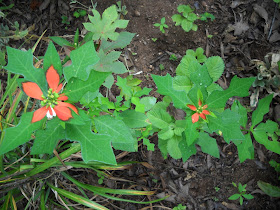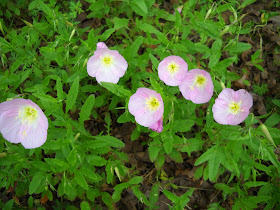I got directions to get to the mall, Trader Joe’s, and some fast food places, all in the same area. I only had to stop once to get redirected, but had to turn around several times on the way and the way back as the street signs here are seldom visible. Maybe there aren’t any. Or not many.
Trader Joe’s, I suppose is someone's idea of a grocery store, but is pretty much a loss on me. They had almost nothing that I recognised. No brand names, and odd flavors and combinations, like avocado flavored popcorn, stir fried artichoke and tofu, and pink Himalayan salt (who needs that anyway). The front windows were painted up with a sign that said, “We have pumpkin fever,” and Boy! did they ever. Fully a third of all products in the store were pumpkin or pumpkin flavored. And just to be clear: I hate pumpkin. I did however recognize apples and bananas and procured some of those. I removed myself from their premises fairly quickly and tried to head back to Firefly Farm.
Heading up a ramp to get on I40, I spotted a Walmart and quickly turned into a car dealership only to discover that because it was an interstate ramp, there was no going back in the other direction. They had thought of a solution to this problem of being located on an interstate ramp though and I was able to wind about through several business parking lots and eventually wound up in the Walmart lot. There I was able to discover actual pepperoni pizza, French bread made from actual flour, and lots of sweets and other junk food. I hate to call it junk food because in my heart, I believe pumpkin flavored instant irish potatoes is the real junk food.
I found a Ross, a TJ Max, and a store called Bargain Hunter. Guess what I found in Bargain Hunter??? Something for my obsession? You betcha. I found a 4.5 pound container of Miracle-Gro continuous release fertilizer for only $6. I felt doubly lucky to get it as it was not only cheap, but was the only one left. This proves my suspicion that there are millions of people out there, just like me, who think of little else except plants.
After navigating thru an endless tangle of roads, I returned after about 5 hours to Firefly Farms. Needing to unwind after my leisure drive, I opted for a walk. I was advised by a local not to go farther than the railroad track as there were homeless people around there. I figured it was alright as I was not carrying any foodstuffs that they might try to wrestle away from me, so I thanked the man and continued on my way. I went to the end of the road where there was a power substation, or something of that sort behind a chain link fence that had warning signs about construction. I can only imagine they could not find any signs that said High Voltage and had to settle for something else.
The vegetation on the walk was pretty boring. Most were tall wildflowers (giving the appearance of weeds) that had gone to seed. The leaves were tattered and moth eaten and the trees were not far enough along in their color development to be pretty. I did see a lone blue chicory flower in a ditch that cheered me up considerably.
Past the railroad track the road led beside a lake (of sorts) but there were giant piles of gravel out in the lake a few yards off shore. Big piles, I mean. Big enough so they had made a road around the perimeter of the gravel pile. Another odd thing was that there were a number of small solar panels set up on the rocks, as well as one on the substation. Well, I can’t figure this out. It is Tennessee, after all. Not a sensible place like Alabama. But maybe I don’t need to go there…
I cooked a pizza and had some wine for supper and fell asleep as per usual pretending to watch TV.







































.jpg)
.jpg)

.jpg)





.jpg)

.jpg)
.jpg)
